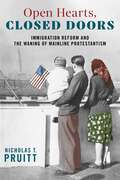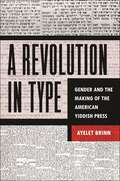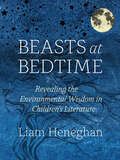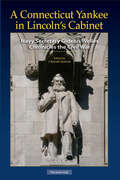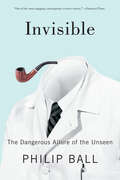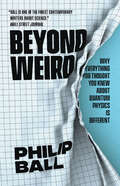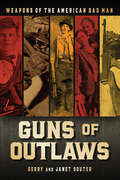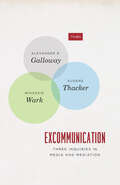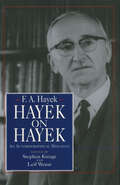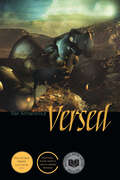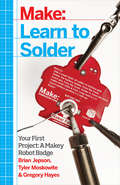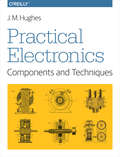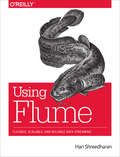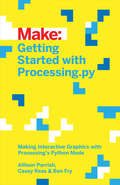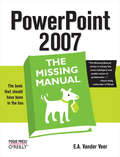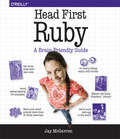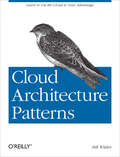- Table View
- List View
Open Hearts, Closed Doors: Immigration Reform and the Waning of Mainline Protestantism
by Nicholas T. PruittA history of mainline Protestant responses to immigrants and refugees during the twentieth centuryOpen Hearts, Closed Doors uncovers the largely overlooked role that liberal Protestants played in fostering cultural diversity in America and pushing for new immigration laws during the forty years following the passage of the restrictive Immigration Act of 1924. These efforts resulted in the complete reshaping of the US cultural and religious landscape.During this period, mainline Protestants contributed to the national debate over immigration policy and joined the charge for immigration reform, advocating for a more diverse pool of newcomers. They were successful in their efforts, and in 1965 the quota system based on race and national origin was abolished. But their activism had unintended consequences, because the liberal immigration policies they supported helped to end over three centuries of white Protestant dominance in American society.Yet, Pruitt argues, in losing their cultural supremacy, mainline Protestants were able to reassess their mission. They rolled back more strident forms of xenophobia, substantively altering the face of mainline Protestantism and laying foundations for their responses to today’s immigration debates. More than just a historical portrait, this volume is a timely reminder of the power of religious influence in political matters.
Brains Confounded by the Ode of Abū Shādūf Expounded, with Risible Rhymes: Volume Two (Library of Arabic Literature #7)
by Yūsuf al-Shirbīnī Muḥammad ibn al-SanhūrīWitty, bawdy, and vicious, Yūsuf al-Shirbīnī’s Brains Confounded pits the “coarse” rural masses against the “refined” urban population. In Volume One, al-Shirbīnī describes the three rural “types”—peasant cultivator, village man-of-religion, and rural dervish—offering anecdotes testifying to the ignorance, dirtiness, and criminality of each. In Volume Two, he presents a hilarious parody of the verse-and-commentary genre so beloved by scholars of his day, with a 47-line poem supposedly written by a peasant named Abū Shādūf, who charts the rise and fall of his fortunes. Wielding the scholarly tools of elite literature, al-Shirbīnī responds to the poem with derision and ridicule, dotting his satire with digressions into love, food, and flatulence. Volume Two of Brains Confounded is followed by Risible Rhymes, a concise text that includes a comic disquisition on “rural” verse, mocking the pretensions of uneducated poets from Egypt’s countryside. Risible Rhymes also examines various kinds of puzzle poems, which were another popular genre of the day, and presents a debate between scholars over a line of verse by the fourth/tenth-century poet al-Mutanabbī. Together, Brains Confounded and Risible Rhymes offer intriguing insight into the intellectual concerns of Ottoman Egypt, showcasing the intense preoccupation with wordplay, grammar, and stylistics and shedding light on the literature of the era.An English-only edition.
Unsettled: American Jews and the Movement for Justice in Palestine
by Professor Oren Kroll-ZeldinExamines how young Jewish Americans’ fundamentally Jewish values have led them to organize in solidarity with PalestiniansUnsettled digs into the experiences of young Jewish Americans who engage with the Palestine solidarity movement and challenge the staunch pro-Israel stance of mainstream Jewish American institutions. The book explores how these activists address Israeli government policies of occupation and apartheid, and seek to transform American Jewish institutional support for Israel.Author Oren Kroll-Zeldin identifies three key social movement strategies employed by these activists: targeting mainstream Jewish American institutions, participating in co-resistance efforts in Palestine/Israel, and engaging in Boycott, Divestment, and Sanctions (BDS) campaigns. He argues that these young people perceive their commitment to ending the occupation and Israeli apartheid as a Jewish value, deeply rooted in the changing dynamics of Jewish life in the twenty-first century. By associating social justice activism with Jewish traditions and values, these activists establish a connection between their Jewishness and their pursuit of justice for Palestinians.In a time of internal Jewish tensions and uncertainty about peace prospects between Palestine and Israel, the book provides hope that the efforts of these young Jews in the United States are pushing the political pendulum in a new direction, potentially leading to a more balanced and nuanced conversation.
Avidly Reads Poetry
by Jacquelyn Ardam“Poetry has leapt out of its world and into the world”Poetry is everywhere. From Amanda Gorman performing “The Hill We Climb” before the nation at Joe Biden’s Presidential inauguration, to poems regularly going viral on Instagram and Twitter, more Americans are reading and interacting with poetry than ever before. Avidly Reads Poetry is an ode to poetry and the worlds that come into play around the different ways it is written and shared.Mixing literary and cultural criticism with the author’s personal and often intimate relationship with poetry, Avidly Reads Poetry breathes life into poems of every genre—from alphabet poems and Shakespeare’s sonnets to Claudia Rankine’s Citizen and Rupi Kaur’s Instapoetry—and asks: How do poems come to us? How do they make us feel and think and act when they do? Who and what is poetry for? Who does poetry include and exclude, and what can we learn from it?Each section links a reason why we might read poetry with a type of poem to help us think about how poems are embedded in our lives, in our loves, our educations, our politics, and our social media, sometimes in spite of, and sometimes very much because of, the nation we live in.Part of the Avidly Reads series, this slim book gives us a new way of looking at American culture. With the singular blend of personal reflection and cultural criticism featured in the series, Avidly Reads Poetry shatters the wall between poetry and “the rest of us.”
A Revolution in Type: Gender and the Making of the American Yiddish Press
by Ayelet Brinn73rd National Jewish Book Awards FinalistA fascinating glimpse into the complex and often unexpected ways that women and ideas about women shaped widely read Jewish newspapersBetween the 1880s and 1920s, Yiddish-language newspapers rose from obscurity to become successful institutions integral to American Jewish life. During this period, Yiddish-speaking immigrants came to view newspapers as indispensable parts of their daily lives. For many Jewish immigrants from Eastern Europe, acclimating to America became inextricably intertwined with becoming a devoted reader of the Yiddish periodical press, as the newspapers and their staffs became a fusion of friends, religious and political authorities, tour guides, matchmakers, and social welfare agencies.In A Revolution in Type, Ayelet Brinn argues that women were central to the emergence of the Yiddish press as a powerful, influential force in American Jewish culture. Through rhetorical debates about women readers and writers, the producers of the Yiddish press explored how to transform their newspapers to reach a large, diverse audience. The seemingly peripheral status of women’s columns and other newspaper features supposedly aimed at a female audience—but in reality, read with great interest by male and female readers alike—meant that editors and publishers often used these articles as testing grounds for the types of content their newspapers should encompass. The book explores the discovery of previously unknown work by female writers in the Yiddish press, whose contributions most often appeared without attribution; it also examines the work of men who wrote under women’s names in order to break into the press. Brinn shows that instead of framing issues of gender as marginal, we must view them as central to understanding how the American Yiddish press developed into the influential, complex, and diverse publication field it eventually became.
Beasts at Bedtime: Revealing the Environmental Wisdom in Children's Literature
by Liam Heneghan“[A] fresh new look at animal tales, often classic, and how they pertain to the present-day and our often fraught relationship to our environment.” —Jeff VanderMeer, author of the Southern Reach TrilogyTalking lions, philosophical bears, very hungry caterpillars, wise spiders, altruistic trees, companionable moles, urbane elephants: this is the magnificent menagerie that delights our children at bedtime. Within the entertaining pages of many children’s books, however, also lie profound teachings about the natural world that can help children develop an educated and engaged appreciation of the dynamic environment they inhabit.In Beasts at Bedtime, scientist (and father) Liam Heneghan examines the environmental underpinnings of children’s stories. From Beatrix Potter to Harry Potter, Heneghan unearths the universal insights into our inextricable relationship with nature that underlie so many classic children’s stories. Some of the largest environmental challenges in coming years—from climate instability, the extinction crisis, freshwater depletion, and deforestation—are likely to become even more severe as this generation of children grows up. Though today’s young readers will bear the brunt of these environmental calamities, they will also be able to contribute to environmental solutions if prepared properly. And all it takes is an attentive eye: Heneghan shows how the nature curriculum is already embedded in bedtime stories, from the earliest board books like The Rainbow Fish to contemporary young adult classics like The Hunger Games.This book enthralls as it engages. Beasts at Bedtime will help parents, teachers, and guardians extend those cozy times curled up together with a good book into a lifetime of caring for our planet.“Beasts at Bedtime is proof that most kidlit has teachable moments embedded in it.” —Toronto Star
Hitler's Master of the Dark Arts: Himmler's Black Knights and the Occult Origins of the SS
by Bill YenneA history of Nazi Germany’s SS and its leader examining the groups mystical cult aspects and Himmler’s rise through the ranks of power.Hitler’s Nazi Party, at its evil roots, embraced a bizarre interpretation of ancient European paganism, blending it with fragments of other traditions from sources as diverse as tenth-century Saxon warlords, nineteenth-century spiritualism, and early-twentieth-century fringe archeology. Even the swastika, the hated symbol of Nazism, had its roots in ancient symbolism, its first recorded appearance carved into a mammoth tusk twelve thousand years before Hitler came to power.At the heart of the evil was Hitler’s “witch doctor,” Heinrich Himmler, and his stranger-than-fiction cult, the deadly SS. The mundanely named Schutzstaffel, literally “protective squadron,” was the very essence of Nazism, and their threatening double lightning bolt was one of the most dreaded symbols of the Third Reich. With good reason: what the SS was truly protecting was the ideology of Aryan superiority.Hitler’s Master of the Dark Arts is the first history of the SS and its leader to focus on the mystical cult aspects of the organization. It follows Himmler’s transformation of the SS from a few hundred members in 1929 to over fifty thousand black-uniformed Aryans by the mid-1930s. Concurrent with its expansion and its eventual independence from the brown shirts of the SA, Himmler infused the Black Knights with a mishmash of occult beliefs and lunatic-fringe theories that would have been completely laughable—except that they were also used to justify the Final Solution.
A Connecticut Yankee in Lincoln's Cabinet: Navy Secretary Gideon Welles Chronicles the Civil War
by Gideon WellesThe U.S. Civil War through the eyes of a key member of President Abraham Lincoln’s cabinet.Gideon Welles, the Connecticut journalist-politician who served as Lincoln’s secretary of the navy, was not only an architect of Union victory but also a shrewd observer of people, issues, and events. Fortunately for posterity, he recorded many of his observations in his extensive diary. A Connecticut Yankee in Lincoln’s Cabinet brings together 250 of the most important and interesting excerpts from the diary, dealing with topics as varied as the issuance of the Emancipation Proclamation, the Marine Band’s concerts in Washington’s Lafayette Square, Lincoln’s sense of humor, rivalries among cabinet members, Welles’s often caustic opinions of prominent politicians and military leaders, demands for creation of a navy yard in his home state, the challenge of blockading 3,500 miles of Confederate coastline, the struggle against rebel commerce raiders, the battles of Antietam and Gettysburg, the Fort Pillow massacre of African American troops, and Lincoln’s assassination. Together, the excerpts provide a candid insider’s view of the Civil War as it unfolded, and an introduction provides the reader with context. Published by the Acorn Club.
Science Fiction and the Mass Cultural Genre System
by John RiederA fresh approach to the history and shape of science fiction In Science Fiction and the Mass Cultural Genre System, John Rieder asks literary scholars to consider what shape literary history takes when based on a historical, rather than formalist, genre theory. Rieder starts from the premise that science fiction and the other genres usually associated with so-called genre fiction comprise a system of genres entirely distinct from the pre-existing classical and academic genre system that includes the epic, tragedy, comedy, satire, romance, the lyric, and so on. He proposes that the field of literary production and the project of literary studies cannot be adequately conceptualized without taking into account the tensions between these two genre systems that arise from their different modes of production, distribution, and reception. Although the careful reading of individual texts forms an important part of this study, the systemic approach offered by Science Fiction and the Mass Cultural Genre System provides a fundamental challenge to literary methodologies that foreground individual innovation.
Invisible: The Dangerous Allure of the Unseen
by Philip Ball“A very fun, largely chronological journey through invisibility, beginning with myth and early magicians, ending with quantum physics.” —The New YorkerIn this lively look at a timeless idea, Ball provides the first comprehensive history of our fascination with the unseen. This sweeping narrative moves from medieval spell books to the latest nanotechnology, from fairy tales to telecommunications, from camouflage to ghosts to the dawn of nuclear physics and the discovery of dark energy. Along the way, Invisible tells little-known stories about medieval priests who blamed their misdeeds on spirits; the Cock Lane ghost, which intrigued both Samuel Johnson and Charles Dickens; the attempts by Victorian scientist William Crookes to detect forces using tiny windmills; novelist Edward Bulwer-Lytton’s belief that he was unseen when in his dressing gown; and military efforts to enlist magicians to hide tanks and ships during WWII. Bringing in such voices as Plato and Shakespeare, Ball provides not only a scientific history but a cultural one—showing how our simultaneous desire for and suspicion of the invisible has fueled invention and the imagination for centuries.In this unusual and clever book, Ball shows that our fantasies about being unseen—and seeing the unseen—reveal surprising truths about who we are.“Full of insights drawn from a broad survey of history, literature and philosophy; wherever the invisible is being contemplated, Ball is there to select the juiciest anecdotes . . . [He] is a lucid, witty and highly entertaining guide.” —The Globe and Mail“A tour-de-force history capped off with an animated discussion of H.G. Wells’s novel The Invisible Man.” —Publishers Weekly (starred review)
Beyond Weird: Why Everything You Thought You Knew about Quantum Physics Is Different
by Philip BallA journey into the mysteries and meaning of quantum theory: “Gorgeously lucid text . . . easily the best book I’ve read on the subject.” —The Washington Post“Anyone who is not shocked by quantum theory has not understood it.” Since Niels Bohr said this many years ago, quantum mechanics has only been getting more shocking. We now realize that it’s not really telling us that “weird” things happen out of sight, on the tiniest level, in the atomic world: rather, everything is quantum. But if quantum mechanics is correct, what seems obvious and right in our everyday world is built on foundations that don’t seem obvious or right at all—or even possible.An exhilarating tour of the contemporary quantum landscape, Beyond Weird is a book about what quantum physics really means—and what it doesn’t. Philip Ball offers an up-to-date, accessible account of the quest to come to grips with the most fundamental theory of physical reality, and to explain how its counterintuitive principles underpin the world we experience. Over the past decade it’s become clear that quantum physics is less a theory about particles and waves, uncertainty and fuzziness, than a theory about information and knowledge—about what can be known, and how we can know it. Discoveries and experiments over the past few decades have called into question the meanings and limits of space and time, cause and effect, and, ultimately, of knowledge itself. The quantum world Ball shows us isn’t a different world. It is our world, and if anything deserves to be called “weird,” it’s us.“Weighs up the competing interpretations, and the misconceptions, that have attached themselves to quantum theory in its 100-year history. . . . [A] laudable achievement.”—Sunday Times“Ball is one of the finest contemporary writers about science. . . . His prose is a pleasure to read.”—Wall Street Journal
Guns of Outlaws: Weapons of the American Bad Man
by Gerry Souter Janet Souter“Chronicles the misdeeds of many of America’s worst miscreants, with special emphasis on the tools of the outlaw trade.” —American RiflemanFrom colonial-era rifles carried on the “Owlhoot Trail” to John Dillinger’s Colt pistols, the history of the American outlaw is told in guns—weapons that became each man’s personal signature. Authors Gerry and Janet Souter peer into these criminals’ choices of derringers, revolvers, shotguns, rifles, machine guns, and curious hybrids, giving us a glimpse into the minds behind the trigger fingers. With over 200 illustrations, Guns of Outlaws gives a unique look at the lives and the hardware of the most infamous outlaws in American history, and of the law enforcement officers who hunted them.As settlers moved further west, away from authority and soft city life into the Great Plains, the push for survival through the endless prairies and jagged isolating mountain ranges bred ruthless men. Most outlaws were technology freaks who seized upon the latest weapon innovations developed in the industrious East to provide an edge in the life-and-death cosmos of the Wild West. By the late 1930s and early 1940s, outlaws on horseback had given way to marauding bank robbers. Using fast cars and faster guns, they became folk heroes of the Great Depression, even as the law was hard on their tails.“Historians Gerry and Janet Souter take the reader back to a time between 1840 and 1940 when . . . outlaws and man hunters lived bold and died hard . . . [The] book show[s] actual tools of the trade wielded during a violent century, bound up in a mix of hard truths and mythology.” —Ammoland.com
Excommunication: Three Inquiries in Media and Mediation (TRIOS)
by Alexander R. Galloway Eugene Thacker McKenzie WarkAlways connect—that is the imperative of today’s media. But what about those moments when media cease to function properly, when messages go beyond the sender and receiver to become excluded from the world of communication itself—those messages that state: “There will be no more messages”? In this book, Alexander R. Galloway, Eugene Thacker, and McKenzie Wark turn our usual understanding of media and mediation on its head by arguing that these moments reveal the ways the impossibility of communication is integral to communication itself—instances they call excommunication. In three linked essays, Excommunication pursues this elusive topic by looking at mediation in the face of banishment, exclusion, and heresy, and by contemplating the possibilities of communication with the great beyond. First, Galloway proposes an original theory of mediation based on classical literature and philosophy, using Hermes, Iris, and the Furies to map out three of the most prevalent modes of mediation today—mediation as exchange, as illumination, and as network. Then, Thacker goes boldly beyond Galloway’s classification scheme by examining the concept of excommunication through the secret link between the modern horror genre and medieval mysticism. Charting a trajectory of examples from H. P. Lovecraft to Meister Eckhart, Thacker explores those instances when one communicates or connects with the inaccessible, dubbing such modes of mediation “haunted” or “weird” to underscore their inaccessibility. Finally, Wark evokes the poetics of the infuriated swarm as a queer politics of heresy that deviates from both media theory and the traditional left. He posits a critical theory that celebrates heresy and that is distinct from those that now venerate Saint Paul. Reexamining commonplace definitions of media, mediation, and communication, Excommunication offers a glimpse into the realm of the nonhuman to find a theory of mediation adequate to our present condition.
Hayek on Hayek: An Autobiographical Dialogue ( The Collected Works of F. A. Hayek)
by F. A. HayekThe crumbling of the Berlin Wall, the fall of the iron curtain, and the Reagan and Thatcher "revolutions" all owe a tremendous debt to F. A. Hayek. Economist, social and political theorist, and intellectual historian, Hayek passionately championed individual liberty and condemned the dangers of state control. Now Hayek at last tells the story of his long and controversial career, during which his fortunes rose, fell, and finally rose again. Through a complete collection of previously unpublished autobiographical sketches and a wide selection of interviews, Hayek on Hayek provides the first detailed chronology of Hayek's early life and education, his intellectual progress, and the academic and public reception of his ideas. His discussions range from economic methodology and the question of religious faith to the atmosphere of post-World War I Vienna and the British character. Born in 1899 into a Viennese family of academics and civil servants, Hayek was educated at the University of Vienna, fought in the Great War, and later moved to London, where, as he watched liberty vanish under fascism and communism across Europe, he wrote The Road to Serfdom. Although this book attracted great public attention, Hayek was ignored by other economists for thirty years after World War II, when European social democracies boomed and Keynesianism became the dominant intellectual force. However, the award of the Nobel Prize in economics for 1974 signaled a reversal in Hayek's fortunes, and before his death in 1992 he saw his life's work vindicated in the collapse of the planned economies of Eastern Europe.Hayek on Hayek is as close to an autobiography of Hayek as we will ever have. In his own eloquent words, Hayek reveals the remarkable life of a revolutionary thinker in revolutionary times. "One of the great thinkers of our age who explored the promise and contours of liberty....[Hayek] revolutionized the world's intellectual and political life"—President George Bush, on awarding F. A. Hayek the Medal of Freedom F. A. Hayek, recipient of the Medal of Freedom 1991 and the Nobel Memorial Prize in Economics in 1974, was a pioneer in monetary theory and the principal proponent of the libertarian philosophy. Hayek is the author of numerous books in economics, as well as books in political philosophy and psychology.
Versed (Wesleyan Poetry Series)
by Rae ArmantroutWinner of the 2010 Pulitzer Prize for PoetryWinner of the Pulitzer Prize for Poetry (2010)Winner of the National Book Critics Circle Award (2009) Rae Armantrout has always organized her collections of poetry as though they were works in themselves. Versed brings two of these sequences together, offering readers an expanded view of the arc of her writing. The poems in the first section, Versed, play with vice and versa, the perversity of human consciousness. They flirt with error and delusion, skating on a thin ice that inevitably cracks: "Metaphor forms / a crust / beneath which / the crevasse of each experience." Dark Matter, the second section, alludes to more than the unseen substance thought to make up the majority of mass in the universe. The invisible and unknowable are confronted directly as Armantrout's experience with cancer marks these poems with a new austerity, shot through with her signature wit and stark unsentimental thinking. Together, the poems of Versed part us from our assumptions about reality, revealing the gaps and fissures in our emotional and linguistic constructs, showing us ourselves where we are most exposed. A reader's companion is available at http://versedreader.site.wesleyan.edu/
Learning Cocoa with Objective-C: Developing for the Mac and iOS App Stores
by Paris Buttfield-Addison Jonathon ManningGet up to speed on Cocoa and Objective-C, and start developing applications on the iOS and OS X platforms. If you don’t have experience with Apple’s developer tools, no problem! From object-oriented programming to storing app data in iCloud, this book covers everything you need to build apps for the iPhone, iPad, and Mac.You’ll learn how to work with the Xcode IDE, Objective-C’s Foundation library, and other developer tools such as Event Kit framework and Core Animation. Along the way, you’ll build example projects, including a simple Objective-C application, a custom view, a simple video player application, and an app that displays calendar events for the user.Learn the application life cycle on OS X and iOSWork with the user-interface system in Cocoa and Cocoa TouchUse AV Foundation to display video and audioBuild apps that let users create, edit, and work with documentsStore data locally with the file system, or on the network with iCloudDisplay lists or collections of data with table views and collection viewsInteract with the outside world with Core Location and Core MotionUse blocks and operation queues for multiprocessing
Learn to Solder: Tools and Techniques for Assembling Electronics
by Brian Jepson Tyler Moskowite Gregory HayesLearn the fundamentals of soldering—and pick up an essential skill for building electronic gadgets. You’ll discover how to preheat and tin your iron, make a good solder joint, desolder cleanly (when things don't quite go right), and how to use helping hands to hold components in place.This concise book is part of MAKE’s Getting Started with Soldering Kit. Using the tools in the kit and some electronic components, you can practice soldering while making fun blinky objects. Then show the world you just learned a new skill by wearing the Learn to Solder Skill Badge.Learn how to prepare your workspaceGet to know the components you’ll work withUse the best methods for soldering components in placeExperience the perfect solder jointKnow how to desolder when things don’t work the first timeHeat up the iron and start soldering today!
Adding Ajax: Making Existing Sites More Interactive
by Shelley PowersAjax can bring many advantages to an existing web application without forcing you to redo the whole thing. This book explains how you can add Ajax to enhance, rather than replace, the way your application works. For instance, if you have a traditional web application based on submitting a form to update a table, you can enhance it by adding the capability to update the table with changes to the form fields, without actually having to submit the form. That's just one example.Adding Ajax is for those of you more interested in extending existing applications than in creating Rich Internet Applications (RIA). You already know the "business-side" of applications-web forms, server-side driven pages, and static content-and now you want to make your web pages livelier, more fun, and much more interactive. This book:Provides an overview of Ajax technologies, and the importance of developing a strategy for changing your site before you sit down to codeExplains the heart and soul of Ajax: how to work with the XMLHttpRequest objectIntroduces and demonstrates several important Ajax libraries, including Prototype, script.aculo.us, rico, MochikitExplores the interactive element that is Ajax, including how to work with events and event handlers that work across browsersIntroduces the concept of web page as space, and covers three popular approaches to managing web spaceExplains how to make data updates, including adding new data, deleting, and making updates, all from within a single pageDescribes the effects Ajax has on the Web-breaking the back button, losing browser history, dynamic effects that disappear when the page is refreshed, and moreCovers advanced CSS effects, including drag and drop "scroll bars", pagination, and the use of SVG and the Canvas objectExplores mashups-Ajax's ability to combine data from different web services in any number of ways, directly in our web pagesYou don't need to start over to use Ajax. You can simply add to what you already have. This book explains how.
Practical Electronics: Components and Techniques
by J. M. HughesHow much do you need to know about electronics to create something interesting, or creatively modify something that already exists? If you’d like to build an electronic device, but don’t have much experience with electronics components, this hands-on workbench reference helps you find answers to technical questions quickly.Filling the gap between a beginner’s primer and a formal textbook, Practical Electronics explores aspects of electronic components, techniques, and tools that you would typically learn on the job and from years of experience. Even if you’ve worked with electronics or have a background in electronics theory, you’re bound to find important information that you may not have encountered before.Among the book’s many topics, you’ll discover how to:Read and understand the datasheet for an electronic componentUse uncommon but inexpensive tools to achieve more professional-looking resultsSelect the appropriate analog and digital ICs for your projectSelect and assemble various types of connectorsDo basic reverse engineering on a device in order to modify (hack) itUse open source tools for schematic capture and PCB layoutMake smart choices when buying new or used test equipment
Using Flume: Flexible, Scalable, and Reliable Data Streaming
by Hari ShreedharanHow can you get your data from frontend servers to Hadoop in near real time? With this complete reference guide, you’ll learn Flume’s rich set of features for collecting, aggregating, and writing large amounts of streaming data to the Hadoop Distributed File System (HDFS), Apache HBase, SolrCloud, Elastic Search, and other systems.Using Flume shows operations engineers how to configure, deploy, and monitor a Flume cluster, and teaches developers how to write Flume plugins and custom components for their specific use-cases. You’ll learn about Flume’s design and implementation, as well as various features that make it highly scalable, flexible, and reliable. Code examples and exercises are available on GitHub.Learn how Flume provides a steady rate of flow by acting as a buffer between data producers and consumersDive into key Flume components, including sources that accept data and sinks that write and deliver itWrite custom plugins to customize the way Flume receives, modifies, formats, and writes dataExplore APIs for sending data to Flume agents from your own applicationsPlan and deploy Flume in a scalable and flexible way—and monitor your cluster once it’s running
Getting Started with Processing.py: Making Interactive Graphics with Processing's Python Mode
by Ben Fry Casey Reas Allison ParrishProcessing opened up the world of programming to artists, designers, educators, and beginners. The Processing.py Python implementation of Processing reinterprets it for today's web. This short book gently introduces the core concepts of computer programming and working with Processing. Written by the co-founders of the Processing project, Reas and Fry, along with co-author Allison Parrish, Getting Started with Processing.py is your fast track to using Python's Processing mode.
PowerPoint 2007: The Missing Manual (Missing Manual)
by E. A. Vander VeerLike every other application in Microsoft Office suite, PowerPoint is loaded with features. So many, in fact, that even veterans don't know where to find them all. Microsoft solved this problem in PowerPoint 2007 by redesigning the user interface with a tabbed toolbar that makes features easy to locate and use. PowerPoint 2007 also boasts improved graphics, additional templates, the ability to save custom layouts, and improved collaboration through SharePoint. One thing Microsoft hasn't improved is its poor documentation. To learn the ins and outs of all the features in PowerPoint 2007, Microsoft merely offers online help. If you're familiar with previous versions of the program, you may be lost the first time you fire up the new PowerPoint; or you would be if it weren't for PowerPoint 2007: The Missing Manual.This book, written specifically for this version of the software, not only offers the basics of how to create, save, set up, run, and print a basic bullets-and-background slideshow, but takes you into the world of multimedia, animation, and interactivity. You'll learn how to add pictures, sound, video, animated effects, and controls (buttons and links) to their slides, along with ways to pull text, spreadsheets, and animations created in other programs. You can also create your own reusable design templates and learn to automate repetitive tasks with macros. Learn how to take advantage of advanced functions (such as adding custom background images) that existed in previous PowerPoint versions, but were so cleverly hidden that few people ever found them.
Mac OS X Snow Leopard: The Missing Manual (The\missing Manual Ser.)
by David PogueFor a company that promised to "put a pause on new features," Apple sure has been busy-there's barely a feature left untouched in Mac OS X 10.6 "Snow Leopard." There's more speed, more polish, more refinement-but still no manual. Fortunately, David Pogue is back, with the humor and expertise that have made this the #1 bestselling Mac book for eight years straight. You get all the answers with jargon-free introductions to:Big-ticket changes. A 64-bit overhaul. Faster everything. A rewritten Finder. Microsoft Exchange compatibility. All-new QuickTime Player. If Apple wrote it, this book covers it.Snow Leopard Spots. This book demystifies the hundreds of smaller enhancements, too, in all 50 programs that come with the Mac: Safari, Mail, iChat, Preview, Time Machine.Shortcuts. This must be the tippiest, trickiest Mac book ever written. Undocumented surprises await on every page.Power usage. Security, networking, build-your-own Services, file sharing with Windows, even Mac OS X's Unix chassis-this one witty, expert guide makes it all crystal clear.
Head First Ruby: A Brain-Friendly Guide
by Jay McGavrenWhat will you learn from this book?What’s all the buzz about this Ruby language? Is it right for you? Well, ask yourself: are you tired of all those extra declarations, keywords, and compilation steps in your other language? Do you want to be a more productive programmer? Then you’ll love Ruby. With this unique hands-on learning experience, you’ll discover how Ruby takes care of all the details for you, so you can simply have fun and get more done with less code.Why does this book look so different?Based on the latest research in cognitive science and learning theory, Head First Ruby uses a visually rich format to engage your mind, rather than a text-heavy approach to put you to sleep. Why waste your time struggling with new concepts? This multi-sensory learning experience is designed for the way your brain really works.
Cloud Architecture Patterns: Using Microsoft Azure
by Bill WilderIf your team is investigating ways to design applications for the cloud, this concise book introduces 11 architecture patterns that can help you take advantage of cloud-platform services. You’ll learn how each of these platform-agnostic patterns work, when they might be useful in the cloud, and what impact they’ll have on your application architecture. You’ll also see an example of each pattern applied to an application built with Windows Azure.The patterns are organized into four major topics, such as scalability and handling failure, and primer chapters provide background on each topic. With the information in this book, you’ll be able to make informed decisions for designing effective cloud-native applications that maximize the value of cloud services, while also paying attention to user experience and operational efficiency.Learn about architectural patterns for:Scalability. Discover the advantages of horizontal scaling. Patterns covered include Horizontally Scaling Compute, Queue-Centric Workflow, and Auto-Scaling.Big data. Learn how to handle large amounts of data across a distributed system. Eventual consistency is explained, along with the MapReduce and Database Sharding patterns.Handling failure. Understand how multitenant cloud services and commodity hardware influence your applications. Patterns covered include Busy Signal and Node Failure.Distributed users. Learn how to overcome delays due to network latency when building applications for a geographically distributed user base. Patterns covered include Colocation, Valet Key, CDN, and Multi-Site Deployment.
